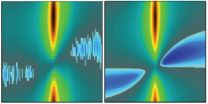(Press-News.org) CAMBRIDGE, MA -- By sequencing cancer-cell genomes, scientists have discovered vast numbers of genes that are mutated, deleted or copied in cancer cells. This treasure trove is a boon for researchers seeking new drug targets, but it is nearly impossible to test them all in a timely fashion.
To help speed up the process, MIT researchers have developed RNA-delivering nanoparticles that allow for rapid screening of new drug targets in mice. In their first mouse study, done with researchers at Dana-Farber Cancer Institute and the Broad Institute, they showed that nanoparticles that target a protein known as ID4 can shrink ovarian tumors.
The nanoparticle system, described in the Aug. 15 online edition of Science Translational Medicine, could relieve a significant bottleneck in cancer-drug development, says Sangeeta Bhatia, the John and Dorothy Wilson Professor of Health Sciences and Technology and Electrical Engineering and Computer Science and a member of the David H. Koch Institute for Integrative Cancer Research at MIT.
"What we did was try to set forth a pipeline where you start with all of the targets that are pouring out of genomics, and you sequentially filter them through a mouse model to figure out which ones are important. By doing that, you can prioritize the ones you want to target clinically using RNA interference, or develop drugs against," says Bhatia, one of the paper's senior authors.
William Hahn, an associate professor of medicine at Harvard Medical School and the paper's other senior author, is the leader of Project Achilles, a collaborative effort to identify promising new targets for cancer drugs from the flood of data coming from the National Cancer Institute's cancer-genome-sequencing project.
Among those potential targets are many considered to be "undruggable," meaning that the proteins don't have any pockets where a traditional drug could bind to them. The new nanoparticles, which deliver short strands of RNA that can shut off a particular gene, may help scientists go after those undruggable proteins.
"If we could figure out how to make this work [in humans], it would open up a whole new class of targets that hadn't been available," says Hahn, who is also director of the Center for Cancer Genome Discovery at Dana-Farber and a senior associate member of the Broad Institute.
Lead authors of the paper are Yin Ren, an MD/PhD student in Bhatia's lab, and Hiu Wing Cheung, a postdoc in Hahn's lab.
An abundance of targets
Through Project Achilles, Hahn and his colleagues have been testing the functions of many of the genes disrupted in ovarian cancer cells. By revealing genes critical to cancer-cell survival, this approach has narrowed the list of potential targets to several dozen.
Typically, the next step in identifying a good drug target would be to genetically engineer a strain of mice that are missing (or overexpressing) the gene in question, to see how they respond when tumors develop. However, this normally takes two to four years. A much faster way to study these genes would be simply to turn them off after a tumor appears.
RNA interference (RNAi) offers a promising way to do that. During this naturally occurring phenomenon, short strands of RNA bind to the messenger RNA (mRNA) that delivers protein-building instructions from the cell's nucleus to the rest of the cell. Once bound, the mRNA molecules are destroyed and their corresponding proteins never get made.
Scientists have been pursuing RNAi as a cancer treatment since its discovery in the late 1990s, but have had trouble finding a way to safely and effectively target tumors with this therapy. Of particular difficulty was finding a way to get RNA to penetrate tumors.
Bhatia's lab, which has been working on RNAi delivery for several years, joined forces with Hahn's group to identify and test new drug targets. Their goal was to create a "mix and dose" technique that would allow researchers to mix up RNA-delivery particles that target a particular gene, inject them into mice and see what happens.
Shrinking tumors
In their first effort, the researchers decided to focus on the ID4 protein because it is overexpressed in about a third of high-grade ovarian tumors (the most aggressive kind), but not in other cancer types. The gene, which codes for a transcription factor, appears to be involved in embryonic development: It gets shut down early in life, then somehow reactivates in ovarian tumors.
To target ID4, Bhatia and her students designed a new type of RNA-delivering nanoparticle. Their particles can both target and penetrate tumors, something that had never before been achieved with RNA interference.
On their surface, the particles are tagged with a short protein fragment that allows them to enter tumor cells. Those fragments are also drawn to a protein found on tumor cells, known as p32. This fragment and many similar ones were discovered by Erkki Ruoslahti, a professor at the Sanford-Burnham Medical Research Institute at the University of California at Santa Barbara, who is also an author of the new paper.
Within the nanoparticles, strands of RNA are mixed with a protein that further helps them along their journey: When the particles enter a cell, they are encapsulated in membranes known as endosomes. The protein-RNA mixture can cross the endosomal membrane, allowing the particles to get into the cell's main compartment and start breaking down mRNA.
In a study of mice with ovarian tumors, the researchers found that treatment with the RNAi nanoparticles eliminated most of the tumors.
The researchers are now using the particles to test other potential targets for ovarian cancer as well as other types of cancer, including pancreatic cancer. They are also looking into the possibility of developing the ID4-targeting particles as a treatment for ovarian cancer.
INFORMATION:
The research was funded by the Howard Hughes Medical Institute, the National Cancer Institute, the National Institutes of Health, the Mary Kay Foundation, the Sandy Rollman Ovarian Cancer Foundation, the Canadian Institutes of Health Research and the H.L. Snyder Medical Foundation.
Written by Anne Trafton, MIT News Office
END
According to a NOAA-led paper published today in the journal Conservation Biology, high levels of background noise, mainly due to ships, have reduced the ability of critically endangered North Atlantic right whales to communicate with each other by about two-thirds.
From 2007 until 2010, scientists from Stellwagen Bank National Marine Sanctuary, Cornell Lab of Ornithology, NOAA Fisheries Northeast Fisheries Science Center, and Marine Acoustics Inc. used an array of acoustic recorders to monitor noise levels, measure levels of sound associated with vessels, and to record ...
VIDEO:
This video shows the annual cycle of global and Asian fatal landslides (for the full dataset described in the research paper).
They have been divided into the 52 weeks...
Click here for more information.
Landslides kill ten times more people across the world than was previously thought, according to research by Durham University, UK.
A new database of hazards shows that 32,300 people died in landslides between 2004 and 2010. Previous estimates ranged from 3,000 ...
WASHINGTON — A new report from the National Research Council presents a prioritized program of basic and applied research for 2013-2022 that will advance scientific understanding of the sun, sun-Earth connections and the origins of "space weather," and the sun's interactions with other bodies in the solar system. This second decadal survey in solar and space physics -- the product of a 18-month effort by more than 85 solar and space physicists and space system engineers -- lays out four scientific goals for the next 10 years along with guiding principles and recommended ...
VIDEO:
This animation shows how large numbers of stars form in the Phoenix Cluster. It begins by showing several galaxies in the cluster and hot gas (in red). This hot gas...
Click here for more information.
Astronomers have found an extraordinary galaxy cluster, one of the largest objects in the universe, that is breaking several important cosmic records. Observations of the Phoenix cluster with NASA's Chandra X-ray Observatory, the National Science Foundation's South ...
A new study by researchers at the University of California, San Diego, and Emory University has uncovered fundamental details about the hexamer structures that make up the tiniest droplets of water, the key component of life – and one that scientists still don't fully understand.
The research, recently published in The Journal of the American Chemical Society (JACS), provides a new interpretation for experimental measurements as well as a vital test for future studies of our most precious resource. Moreover, understanding the properties of water at the molecular level ...
A massive galaxy cluster nearly six billion light years from Earth has been discovered with an astounding and unexpected burst of star formation – more prodigious than any galaxy cluster yet observed, an international team of astronomers and NASA announced today.
In a wide-ranging discussion on the eve of the announcement, two of the leading astronomers on the project talked about the record-breaking galaxy cluster, called Phoenix, and how its surprising properties are prompting astronomers to re-think how galaxy clusters – among the largest structures in the universe ...
A long-time staple of science fiction is the tractor beam, a technology in which light is used to move massive objects – recall the tractor beam in the movie Star Wars that captured the Millennium Falcon and pulled it into the Death Star. While tractor beams of this sort remain science fiction, beams of light today are being used to mechanically manipulate atoms or tiny glass beads, with rapid progress being made to control increasingly larger objects. Those who see major roles for optomechanical systems in a host of future technologies will take heart in the latest results ...
JUPITER, FL, August 15, 2012 – Working with a national team of researchers, a scientist from the Florida campus of The Scripps Research Institute has shown for the first time a link between low levels of a specific hormone and increased risk of metabolic disease in humans.
The study, published online ahead of print in The Journal of Clinical Endocrinology & Metabolism, focuses on the hormone adropin, which was previously identified by Scripps Research Associate Professor Andrew Butler's laboratory during an investigation of obese and insulin-resistant mice. Adropin is ...
Astronomers have found an extraordinary galaxy cluster — one of the largest objects in the universe — that is breaking several important cosmic records. The discovery of this cluster, known as the Phoenix Cluster, made with the National Science Foundation's South Pole Telescope, may force astronomers to rethink how these colossal structures, and the galaxies that inhabit them, evolve.
Follow-up observations made in ultraviolet, optical and infrared wavelengths show that stars are forming in this object at the highest rate ever seen in the middle of a galaxy cluster. The ...
CORAL GABLES, FL (August, 15, 2012)--University of Miami scientists have developed a way to switch fluorescent molecules on and off within aqueous environments, by strategically trapping the molecules inside water-soluble particles and controlling them with ultraviolet light. The new system can be used to develop better fluorescent probes for biomedical research.
Previous studies have used water-soluble particles to bring organic molecules into water. What is novel about this system is the use of a photoswitching mechanism in combination with these particles.
The findings ...





